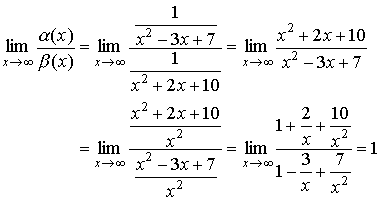| Example 1 |
Infinitesimal functions
![]() and
and ![]()
have the same order as ![]() , since
, since

which is a finite number.
| Example 2 |
Given infinitesimal functions
![]() and
and ![]() ,
,
as ![]() , find the limit of their ratio.
, find the limit of their ratio.
Solution:

The limit equals zero. Therefore, ![]() is an infinitesimal function of the
higher order of smallness with respect to
is an infinitesimal function of the
higher order of smallness with respect to ![]() .
.
| Example 3 |
If ![]() and
and ![]() , then
, then ![]() is an infinitesimal function of the
third order with respect to
is an infinitesimal function of the
third order with respect to ![]() as
as ![]() .
.
Really,
 ,
,
which is a finite number.
| Example 4 |
Given infinitesimal functions ![]() and
and ![]() as
as ![]() , find the limit of their ratio.
, find the limit of their ratio.

| Example 5 |
Both functions,
![]() and
and ![]() ,
,
are infinitesimal functions as ![]() .
.
Find the limit of their ratio:

Since the limit equals 1, ![]() and
and ![]() are equivalent infinitesimal functions
as
are equivalent infinitesimal functions
as ![]() .
.
